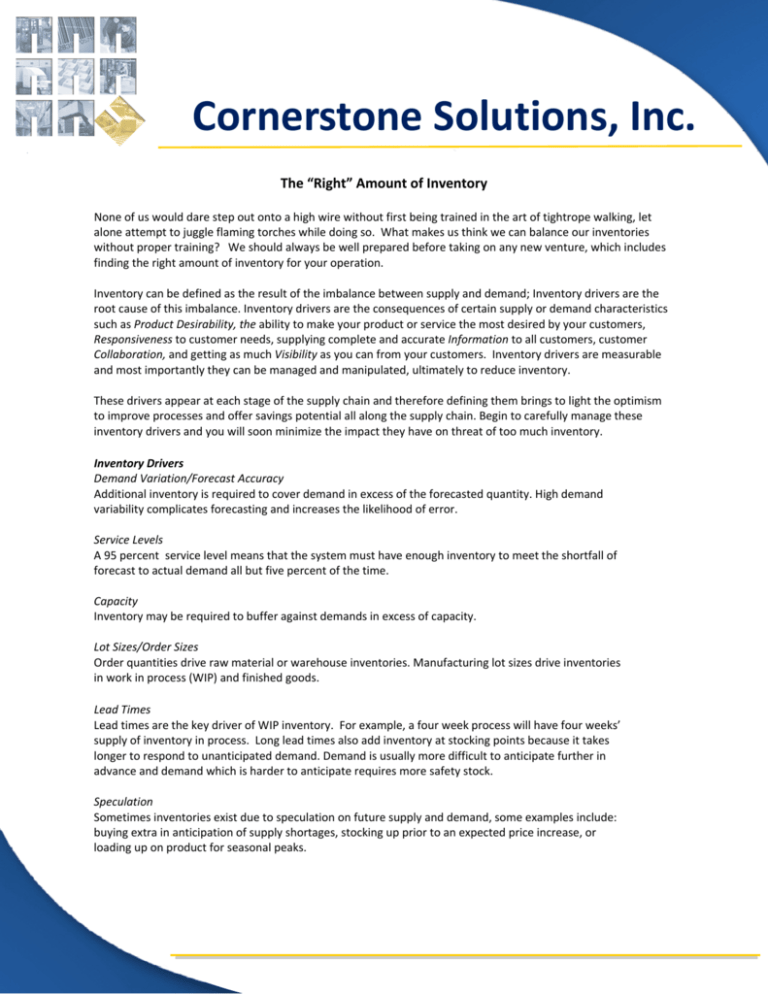
Cornerstone Solutions, Inc. The “Right” Amount of Inventory None of us would dare step out onto a high wire without first being trained in the art of tightrope walking, let alone attempt to juggle flaming torches while doing so. What makes us think we can balance our inventories without proper training? We should always be well prepared before taking on any new venture, which includes finding the right amount of inventory for your operation. Inventory can be defined as the result of the imbalance between supply and demand; Inventory drivers are the root cause of this imbalance. Inventory drivers are the consequences of certain supply or demand characteristics such as Product Desirability, the ability to make your product or service the most desired by your customers, Responsiveness to customer needs, supplying complete and accurate Information to all customers, customer Collaboration, and getting as much Visibility as you can from your customers. Inventory drivers are measurable and most importantly they can be managed and manipulated, ultimately to reduce inventory. These drivers appear at each stage of the supply chain and therefore defining them brings to light the optimism to improve processes and offer savings potential all along the supply chain. Begin to carefully manage these inventory drivers and you will soon minimize the impact they have on threat of too much inventory. Inventory Drivers Demand Variation/Forecast Accuracy Additional inventory is required to cover demand in excess of the forecasted quantity. High demand variability complicates forecasting and increases the likelihood of error. Service Levels A 95 percent service level means that the system must have enough inventory to meet the shortfall of forecast to actual demand all but five percent of the time. Capacity Inventory may be required to buffer against demands in excess of capacity. Lot Sizes/Order Sizes Order quantities drive raw material or warehouse inventories. Manufacturing lot sizes drive inventories in work in process (WIP) and finished goods. Lead Times Lead times are the key driver of WIP inventory. For example, a four week process will have four weeks’ supply of inventory in process. Long lead times also add inventory at stocking points because it takes longer to respond to unanticipated demand. Demand is usually more difficult to anticipate further in advance and demand which is harder to anticipate requires more safety stock. Speculation Sometimes inventories exist due to speculation on future supply and demand, some examples include: buying extra in anticipation of supply shortages, stocking up prior to an expected price increase, or loading up on product for seasonal peaks. Executive Summary What is the “Right” Amount of Inventory? At any point in the supply chain, we need just enough inventory to prevent unplanned shortages while we wait for replenishment. The following approaches will help you determine the “right” amount of inventory. Approach #1 ‐ EOQ & Safety Stock Economic Order Quantities attempt to set lot sizes by balancing order costs and carrying costs. This approach is flawed for a few reasons: carrying costs are usually underestimated, order costs are assumed to be variable or are not reduced, the incorrect assumption that all inventory will be sold, shortage costs may not be considered, and finally, safety stocks are often set arbitrarily or by trial and error. Safety Stock, which is holding extra inventory to protect against stock‐outs, puts undue stress on financial resources. Approach #2 ‐ Let the System Tell Me ERP/DRP systems will drive inventories according to their planning parameters, and often generate data based upon incorrect data input. One has to be careful because systems do as they are told. Forecasts are incorrectly assumed to be correct when they are not, “fudge factors” are often built in but are not recognized, and parameters are often incorrect or conservative. Approach #3 ‐ Model “Should‐Be” Inventories A more appropriate approach is to model the “should‐be” inventories for your operation based on your Inventory Drivers (as mentioned above) such as forecast accuracy, service level targets, lead times and supply reliability, supply chain capacity and lot sizes. Data is often maintained on each of these variables by most companies. Inventory Models can provide a comparison of “should be” vs. actual and will highlight problem areas. Another benefit of inventory models is once they are built, the variables in the models can be changed to perform “what‐
if” analyses. Inventory models should be used primarily for two reasons. First, to further the organization’s understanding of the factors influencing its inventory investment. And second, to help focus inventory reduction efforts on the root causes that will provide the best results. However, the use of inventory models is not effective when the most important root causes of excess inventory are already known. It is safe to say that the appropriate amount of inventory can be determined analytically and sustainable inventory reduction is possible by addressing inventory drivers. Remember that better tools are available to help you optimize your supply chain.
About the Author Gregg St John is former Director of Professional Services at Cornerstone Solutions, a leader in supply chain management services. Contact Cornerstone at 260‐496‐8259 or via email at info@cornerstones.com. For more information about Cornerstone Solutions, Inc., please visit www.cornerstones.com. TM
©2008 l All rights reserved l Cornerstone Solutions, Inc. l 260.496.8259 l www.cornerstones.com








